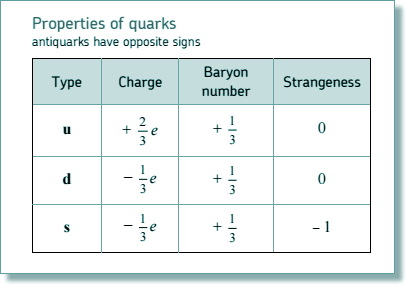Particle Physics Questions
Q12.
The equation shows an interaction between a proton and a negative kaon that results in the formation of particle, X.
K– + p → K+ + K0 + X
(a)
(i) State and explain whether X is a charged particle.
Yes, it is charged - it is negative.
| |
K– |
+ |
p |
→ |
K+ |
+ |
K0 |
+ |
X |
| charge conservation |
-1 |
+ |
+1 |
→ |
+1 |
+ |
0 |
+ |
-1 |
The reactants are negative and positive - resulting in a zero charge - therefore to conserve charge the products must also result in zero overall charge.
[2 marks]
(ii) State and explain whether X is a lepton, baryon or meson.
X must be a baryon.
| |
K– |
+ |
p |
→ |
K+ |
+ |
K0 |
+ |
X |
baryon conservation |
0 |
+ |
+1 |
→ |
0 |
+ |
0 |
+ |
+1 |
[2 marks]
(iii) State the quark structure of the K–, K+ and the K0.

kaon |
quark |
antiquark |
|
| K– |
s |
̅u̅ |
 |
K+ |
u |
̅s̅ |
 |
K0 |
s |
̅d̅ |
 |
or K0 |
d |
̅s̅ |
|
[3 marks]
(iv) Strangeness is conserved in the interaction. Determine, explaining your answer, the quark structure of X.
| |
K– |
+ |
p |
→ |
K+ |
+ |
K0 |
+ |
X |
quark composition |
strangeness conservation |
-1 |
+ |
0 |
→ |
+1 |
+ |
+1 |
+ |
-3 |
sss  |
or |
-1 |
+ |
0 |
→ |
+1 |
+ |
-1 |
+ |
-1 |
dds  |

su̅ + uud →us̅ + sd̅ + X
cancelling the quarks and same flavour antiquark on each side we get:
s + ud → u + d̅ + X
cancelling the quarks that undergo no change
s + d → d̅ + X
X must therefore be dds

su̅ + uud →us̅ + ds̅ + X
cancelling the quarks and same flavour antiquark on each side we get:
s + ud →us̅ + ds̅ + X
cancelling the quarks that undergo no change
s →s̅ + s̅ + X
X must therefore be sss
[3 marks]


